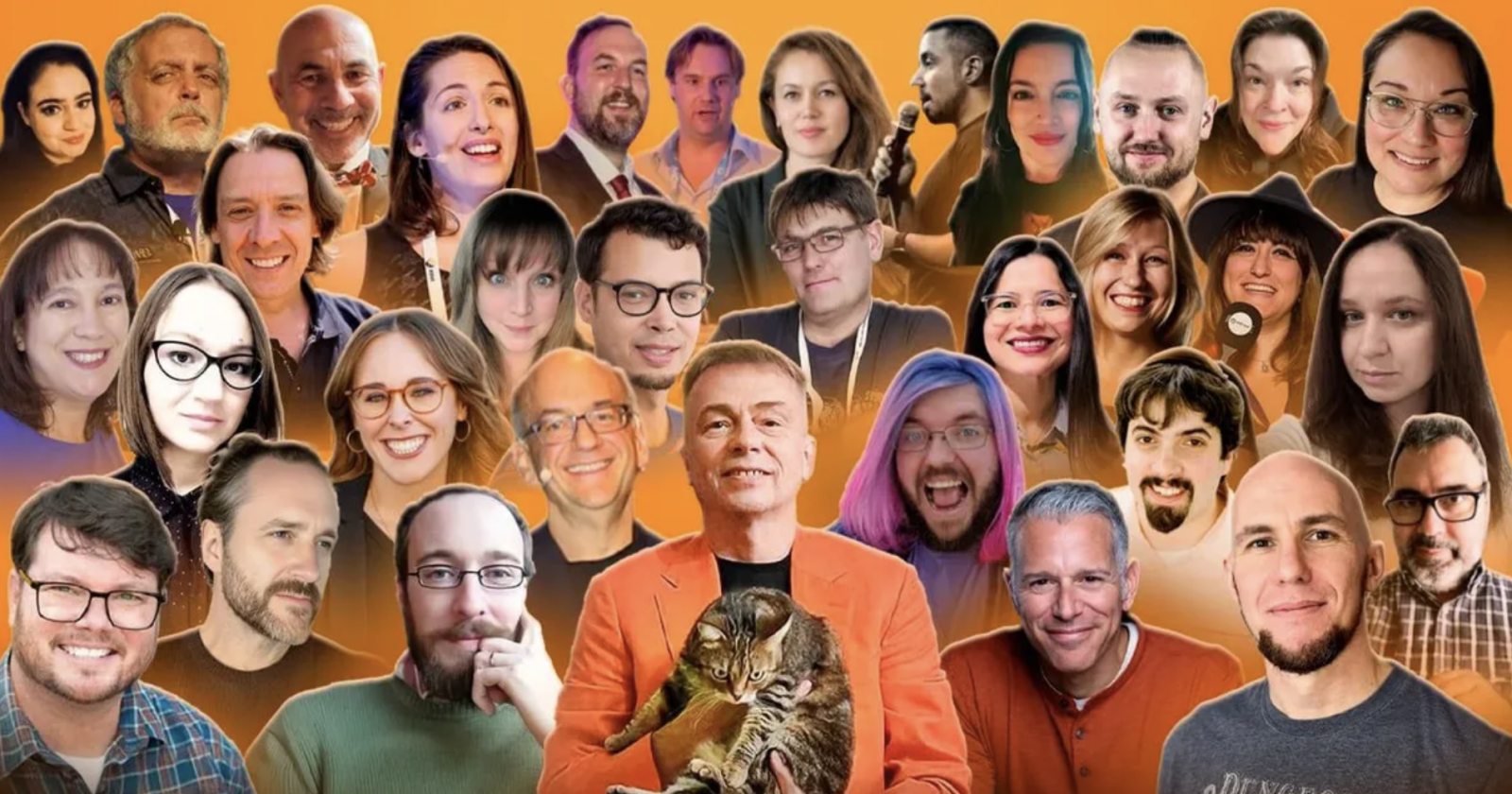11 Expansive Cinematic Universes That Aren't Marvel or Star Wars
The idea of a third Ant-Man and the Wasp got you down? Bored with the fourteenth spin-off of the third Star Wars movie? I’m here to praise, rather than bury, expansive multi-media universes, but Marvel, DC, Star Wars, and...

Screenshot: Annabelle: Creation/New Line Cinema
The idea of a third Ant-Man and the Wasp got you down? Bored with the fourteenth spin-off of the third Star Wars movie? I’m here to praise, rather than bury, expansive multi-media universes, but Marvel, DC, Star Wars, and (to an increasing extent) even Star Trek take up an awful lot of the oxygen in the room (and you know how much oxygen there is in space).
Cinematic Universes are big business now, with everyone trying to get a piece of what Marvel built. Most haven’t had nearly so much luck (a reboot is underway at DC; Universal’s attempt at a modern monster-verse fell apart quickly; Sony’s plans for a web of Spider-Man-adjacent movies is unraveling after Morbius). And yet the studios keep trying: John Wick Chapter 4 is out soon, and a spinoff and TV series are already in the works. There’s just too much money on the line to stop at one movie, or even one quadrilogy.
If none of that sounds particularly appealing but you still have a bit of time on your hands, there are other expansive TV/Movie universes, past and present, that might suit your fancy.
You’ve almost certainly heard of this one, but perhaps don’t know just how expansive it is, involving eight films (to date) and a miniseries from DC Comics. Representing a highly fictionalized take on the case files of demonologists/bullshit artists Ed and Lorraine Warren (of Amityville Horror fame), the first Conjuring was a highly effective haunted house movie and a surprise hit, grossing somewhere in the neighborhood of 15 times its production budget. That film included a cameo from creepy doll superstar Annabelle, who quickly earned her own (forgettable, but money-making ) spinoff. A Conjuring sequel was followed by another (much improved) Annabelle prequel, and it’s all continued to spiral from there. The movies aren’t all spectacular, but they’re all competently made and diverting enough when a bit of spookiness is called for. They’re also impressively internally consistent, with characters (and demons) popping up across movies; the series’ internal timeline runs from Annabelle’s origin in 1943 to 1981, the timeframe of the third Conjuring.
Highlights: The Conjuring and The Conjuring 2, as well as Annabelle: Creation. The series gets its own Avengers: Endgame in Annabelle Comes Home, during which the various demons locked in the Warren family’s museum of crap get loose and run wild for a bit.
Where to stream: The movies are scattered about, but Conjuring 1 & 2 are currently both on Netflix.
It’s left to Whovians to decide the extent to which each new Doctor
is a new character; a
rguably
the show became a mini-franchise just three years after its premiere when First Doctor William Hartnell regenerated into Second Doctor Patrick Troughton. Subsequent Doctors share traits in common with their predecessors, but the actors have clearly never felt any pressure to play the same character. That willingness to change has brought an impressive amount of variety to the series
over the decades, as has the
ever-changing cast of friends, companions, and
memorable villains.
That’s been enough to sustain the concept across nearly 900 TV episodes (and a TV movie), but there’s more to explore.
T
he
first spin
off, K-9 and Company, was short-lived, but others have fared better: Four seasons of Torchwood followed the Cardiff-based government agency charged with defending Earth from invasion; The Sarah Jane Adventures followed the title ‘
70s-era companion across five seasons as an investigative journalist with some plucky young friends. The Doctor’s adventures have expanded into endless novels and comics, but so have those of any number of
side characters. Big Finish Productions, a UK-based publisher of high-end audio dramas, has created stories that expand every corner of the Whoniverse, usually with the original actors but sometimes by placing new characters in familiar settings. The point is: if you’ve any interest at all in time-traveling science-fiction, you could spend the rest of your life exploring without running out of stories.
Highlights: There’s really far too much to choose from. Best to dive in anywhere and see where the TARDIS takes you.
Where to stream: Classic Who is on Brit Box, while the more recent series is on HBO Max (as are Torchwood and Sarah Jane).
This one gets a little complicated: the original Law & order series ran for 20 seasons beginning way back in 1990 (it’s since been revived, and is currently airing its 22nd season). That series spun-off Special Victims Unit, now in its 24th consecutive season starring Mariska Hargitay and, for a dozen years, Christopher Meloni. Organized Crime is a relative newbie in its third season, while Criminal Intent ran for a decade starting in 2001; a handful of less-successful spin-offs ran for a season each. Characters like Chris Noth’s Mike Logan, Jerry Orbach’s Lennie Brisco, and S. Epatha Merkerson’s Anita Van Buren move (or moved) freely between series, usually as guest stars but occasionally transferring full time. There’s even a 1998 TV movie, Exile, that expands on the format.
There’s more, though! Dick Wolf’s other two major franchises are in the same universe, and occasionally crossover: that includes the four shows of the Chicago franchise (three of them ongoing), and the three shows in the FBI franchise.
But let’s say that you make it through that few thousand hours of television (and heaven help you), there’s one further road to go down with Richard Belzer’s John Munch. That SVU character was originally a regular on the unrelated Homicide: Life on the Street, retroactively placing that (excellent) series within the Law & Order orbit. Belzer then goes on to claim the record for number of appearances of the same character in different TV shows, some silly, and some serious, and technically bringing The Wire and The X-Files to your L&O universe binge, as well as Arrested Development and 30 Rock if you want to get really wild. Idris Elba’s Luther references Munch as his contact with the New York SVU contact, so toss that one in as well.
Highlights: I’d say Homicide: Life on the Street, but it’s not streaming anywhere at the moment. This is one of our most consistent franchises, with recurring character threads but mostly standalone episodes, so dive in just about anywhere.
Where to stream: Law & Order and SVU are both on Peacock, as are the Chicago shows.
Sylvester Stallone’s original Rocky film doesn’t feel like the start of a long-running franchise; the movie was nominated for a number of Academy Awards (including one for Stallone’s screenplay), and won Best Picture and Best Director Oscars that year. The subsequent sequels never quite convince us they have anything to say that the first film didn’t already say better, and each one feels a bit staler than the previous, but they’re mostly still entertaining underdog sports dramas. Until 1990's Rocky V, which despite having the original film’s director John G. Avildsen at the helm, feels like a reasonable time to throw in the towel. Then came 2006 and Rocky Balboa, a soft-reboot that leans heavily on nostalgia but still manages to feel like a welcome revisitation. It also made decent money, and paved the way for the spin-off Creed, starring Michael B. Jordan and directed by Ryan Coogler. With a solid screenplay, sharp direction, and great performances from Stallone and Jordan, the movie kicked off a new era in the franchise. A third Creed film is now on the way, and there’s talk of a seventh Rocky movie (an epilogue, according to Stallone), as well as a prequel focusing on Dolph Lundgren’s Ivan Drago from Rocky IV.
Highlights: Start either at the beginning, with the 1976 Rocky, or with 2015's Creed. They’re both excellent, though watching Creed and Creed II now would allow you to pick up with the third film, coming in March.
Where to stream: The Rocky movies are scattered around Netflix, Prime Video, and Paramount+, while Creed is on Sling and the TNT and TBS streaming channels.
Kevin Smith certainly couldn’t have envisioned being the progenitor of a multi-media shared universe when he sold off his comic book collection to finance raunchy indie classic Clerks back in 1994. But here we are, nearly three decades later, and the third film in that series was just released. In between, we’ve largely seen Jay and Silent Bob (Jason Mewes and Smith) as the leading men of the View Askewniverse, popping over to Mallrats in 1995, then Chasing Amy, then Dogma, before fully taking center stage in Jay and Silent Bob Strike Back. The stoner pals have been the connective tissues across nine movies, so far, as well as an animated series, a ton of comics, and, of course...Scream 3; feel free to add that series to your baked binge watch.
Highlights: Clerks is still great, and Dogma is intermittently brilliant.
Where to stream: Several of the movies, including Clerks (and Scream 3), are streaming on Paramount+. Sadly, due to rights issues, seeing Dogma will require you to hunt down an out-of-print DVD.
The worlds of Ju-On and Ring, two Japanese horror mega-franchises that made it big in North America, weren’t linked until 2016, roughly two decades after they kicked off. Ju-on, also known as The Grudge, began as a couple of short films and expanded into the 2002 Takashi Shimizu movie that introduced the house in Tokyo haunted by (justifiably) vengeful ghost Kayako and her even more creepy ghost kid, Toshio, both murder victims (hence the grudge). That movie spawned three direct sequels, as well as several shorter works, novelizations, a video game, and TV series.
Ring, meanwhile, based on a series of novels from Koji Suzuki, gave the world the somewhat less-sympathetic Sadako, a serial killer who curses people with her doomed VHS tape before memorably popping out of the TV screen. Hideo Nakata directed the first major adaptation (after an ealier TV movie), generating six sequels to date, as well as numerous side projects (a TV series, a South Korean remake, manga, etc.)
Both Grudge and Ring, of course, generated American remakes which went on to spawn sequels themselves (and, for The Grudge, a remake of the remake), though, for our purposes, those are in unrelated universes. 2016, though, saw Japan’s answer to Freddy vs. Jason in Sadako vs. Kayako: Sadako, it seems, is back on her videotape bullshit, and the young woman cursed to die is informed, helpfully, that the only way to stop Sadako is to summon an equally vengeful demon and pit them against each other, Celebrity Deathmatch-style. Promotion for the movie included a baseball exhibition involving Toshio and the two women, all of whom are very good at curses and murder, less good at sports.
Highlights: The original Japanese Grudge movie is pretty good, and the first Ring movie is great. The American The Ring from 2002 is excellent, and Sadako vs. Kayako is wonderfully silly.
Where to stream: The first three Japanese Ring movies are on Shudder and Tubi, and Sadako vs. Kayako is on Shudder. The first Ju-on is on Freevee.
Perhaps you need more tonal variety in your shared universe...or maybe you’re looking for one to grow up with? Robert Rodriguez has you covered. There are four films in the appropriately child-friendly Spy Kids series, written and directed by Rodriguez between 2001 and 2011 (there’s also a two-season animated series and a fifth film, apparently a reboot, is on the way). They’re generally a ton of fun! But then it gets interesting.
Grindhouse, from 2007, which teamed Rodriguez with Quentin Tarantino, included as fake trailer for a Spy Kids spin-off starring Danny Trejo as Isador “Machete” Cortez, a character who appeared in each of those movies. But then the writer/director went ahead and did it...creating a joyously tasteless and violent film around Trejo’s character, one that inspired a sequel of its own that added some science fiction to that hard-R series.
Highlights: Start with the first couple of Spy Kids movies when you’re 12 or so, and then jump over to Machete once you turn 18.
Where to stream: The Spy Kids movies are all over the place, but the first one is streaming on Pluto. The first of the two Machete movies is on Sling.
I’m not talking about the largely failed attempts to create a modern monster universe with movies like the Tom Cruise The Mummy, but the original monster series from Universal Studios that bagged with Dracula in 1931 and came to encompass roughly 40 films, depending on how you slice things. The early heavy hitters were the aforementioned Dracula, a blockbuster that virtually gave birth to the horror-movie industry, and Frankenstein, which did far better. The early movies weren’t marketed as B-pictures or monster movies per se, but as serious literary adaptations from star directors. Then, as now, though, horror fans are voracious, and the temptation to churn out product quickly became overwhelming.
There’d been an impressive commitment to continuity from the Frankenstein series, but the first film to begin to connect the various mainline monster movies came in 1943 with Frankenstein Meets the Wolf Man, pitting Lon Chaney Jr. wolf against Frank, now played by Dracula’s Bela Lugosi (these movies were swapping actors long before their plots began to intersect—Chaney had played Frankenstein the year before, and would play Dracula’s son after this). it was the first of what came to be called “monster rallies;” in 1944, House of Frankenstein would unite the Wolf Man, Dracula, and Frankenstein (Boris Karloff even shows up, playing a new, human character). House of Dracula from 1945 would do something similar. Those efforts to boost the flagging monster series feel a little stale, but it’s still fun to see them all hanging out.
More fun still is 1948's Abbott and Costello Meet Frankenstein, a smart, funny epilogue to the Universal years that sees Bela Lugosi back in his Dracula cape alongside Chaney’s Wolf Man and Frankenstein (played by Glenn Strange here), and even includes a cameo from Vincent Price as the Invisible Man. It’s a comedy, so don’t look for continuity, but also an affectionate parody, and no sillier than some of the later monster movies. I’m stopping the Universal Monsterverse there; the later Abbott and Costello monster flicks aren’t nearly as enjoyable, and while late entry Creature from the Black Lagoon is worth watching, it lacks any connections with the older series.
Highlights: Bride of Frankenstein is a probably the best of the bunch, and a great movie in any genre. The aforementioned Abbott and Costello Meet Frankenstein is great if you’re looking for something lighter.
Where to stream: None of the primary Universal monster movies are streaming for free currently, but they’re all available via digital rental.
Well over 100 films, going back to the 1940s, depict real-life martial artist, physician, and folk hero Wong Fei-hung; those films are only sporadically connected and only sporadically available, so catching up on the entire Wong ouevre is likely going to be far too big a hill to climb. There’s a way in, though, that provides for a more cohesive experience and offers up some of the best examples of the genre. Jackie Chan played Wong in Drunken Master, from 1978, in an action-comedy directed by Yuen Woo-ping, who continues to direct films in both Honk Kong and Hollywood, and was responsible for fight choreography in movies like The Matrix and Crouching Tiger, Hidden Dragon. Drunken Master was wildly influential, leading to a sequel, Drunken Master II (called The Legend of Drunken Master in some U.S. releases), and a spin-off, Dance of the Drunk Mantis, which follows the Beggar So character (also a real-life martial artist) from the Chan film, once again played by Yuen Siu-Tin. That one was itself followed by two sequels (Story of Drunken Master and World of Drunken Master). In 2010, director Yuen returned to this world with True Legend, a prequel dealing with Beggar So’s rise.
Highlights: Don’t skip Drunken Master, an all-time great martial arts film.
Where to stream: Drunken Master is on Prime Video, Tubi, and Crackle, while Dance of the Drunk Mantis and True Legend are on Tubi.
The biggest, most expansive cinematic universe of them all is the one you’ve never heard of (yeah, yeah...I know you have). The filmmakers at Full Moon Features (lead by producer/director Charles Band) created their own take on Child’s Play with the direct-to-video 1989 hit Puppet Master, about a group of psychics under assault from the title puppets, animated by an ancient Egyptian spell by soon-to-be recurring character Toulon. The 14th(!) Puppet Master film came out in 2022, counting spin-offs and prequels.
Even setting Puppet Master aside, the company has been incredibly prolific. 1993 saw the release of Dollman vs. Demonic Toys, which linked two earlier movies and threw in a character from a Full Moon movie called Bad Channels for good measure. 2004's Puppet Master vs. Demonic Toys tied those franchises together (though die-hard fans question its canonicity). Later entries connected movies like Subspecies, Evil Bong, Gingerdead Man, etc., which brings the number of films in your Full Moon binge-watch to over 40 (and counting). The connections go back as far as 1984, retroactively adding in earlier Charles Band movies from before Full Moon.
Highlights: Trancers, a retroactive addition to the shared universe, is probably Band’s best. Subspecies and the first and third Puppet Master movies are absurd and thoroughly entertaining. Anyone who’s seen the entire series, please chime in.
Where to stream: Puppet Master is widely available; Shudder and Tubi are your best bets for other films in the series.
Maybe you need something a bit less intense, and don’t want to worry about connecting canonical dots between various film and TV properties. No problem! Head back to the 1980s and dive into the occasionally problematic but mostly delightful world of John Hughes films, many of which are set in fictional Shermer, Illinois, based on teenaged Hughes’ hometown of Northbrook, Illinois. To watch Sixteen Candles, The Breakfast Club, Weird Science, Ferris Bueller’s Day Off, Planes, Trains and Automobiles, National Lampoon’s Vacation, Home Alone, or the lesser-remembered Reach the Rock (all written and or directed by Hughes, and all set in, or referencing Shermer), you don’t have to keep notes or watch in any particular order to get the idea. You can just imagine that characters from various films will run into each other from time to time.
Highlights: I’m rather partial to Ferris Bueller, myself.
Where to stream: They’re scattered around, but all (except for Reach the Rock) are at least available for digital rental.

 Lynk
Lynk 

































